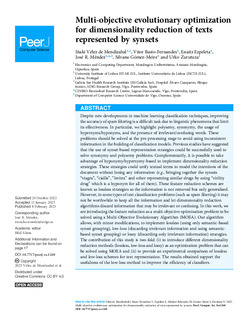| dc.rights.license | Attribution 4.0 International | * |
| dc.contributor.author | Velez de Mendizabal, Iñaki | |
| dc.contributor.author | Ezpeleta, Enaitz | |
| dc.contributor.author | Zurutuza, Urko | |
| dc.contributor.other | Basto-Fernandes, Vitor | |
| dc.contributor.other | Méndez, José R. | |
| dc.contributor.other | Gomez-Meire, Silvana | |
| dc.date.accessioned | 2023-02-24T10:14:59Z | |
| dc.date.available | 2023-02-24T10:14:59Z | |
| dc.date.issued | 2023 | |
| dc.identifier.issn | 2376-5992 | en |
| dc.identifier.other | https://katalogoa.mondragon.edu/janium-bin/janium_login_opac.pl?find&ficha_no=171546 | en |
| dc.identifier.uri | https://hdl.handle.net/20.500.11984/5997 | |
| dc.description.abstract | Despite new developments in machine learning classification techniques, improving the accuracy of spam filtering is a difficult task due to linguistic phenomena that limit its effectiveness. In particular, we highlight polysemy, synonymy, the usage of hypernyms/hyponyms, and the presence of irrelevant/confusing words. These problems should be solved at the pre-processing stage to avoid using inconsistent information in the building of classification models. Previous studies have suggested that the use of synset-based representation strategies could be successfully used to solve synonymy and polysemy problems. Complementarily, it is possible to take advantage of hyponymy/hypernymy-based to implement dimensionality reduction strategies. These strategies could unify textual terms to model the intentions of the document without losing any information (e.g., bringing together the synsets “viagra”, “ciallis”, “levitra” and other representing similar drugs by using “virility drug” which is a hyponym for all of them). These feature reduction schemes are known as lossless strategies as the information is not removed but only generalised. However, in some types of text classification problems (such as spam filtering) it may not be worthwhile to keep all the information and let dimensionality reduction algorithms discard information that may be irrelevant or confusing. In this work, we are introducing the feature reduction as a multi-objective optimisation problem to be solved using a Multi-Objective Evolutionary Algorithm (MOEA). Our algorithm allows, with minor modifications, to implement lossless (using only semantic-based synset grouping), low-loss (discarding irrelevant information and using semantic-based synset grouping) or lossy (discarding only irrelevant information) strategies. The contribution of this study is two-fold: (i) to introduce different dimensionality reduction methods (lossless, low-loss and lossy) as an optimization problem that can be solved using MOEA and (ii) to provide an experimental comparison of lossless and low-loss schemes for text representation. The results obtained support the usefulness of the low-loss method to improve the efficiency of classifiers. | en |
| dc.description.sponsorship | Gobierno de España | es |
| dc.description.sponsorship | Gobierno Vasco-Eusko Jaurlaritza | es |
| dc.language.iso | eng | en |
| dc.publisher | PeerJ | en |
| dc.rights | © 2023 The Authors | en |
| dc.rights.uri | http://creativecommons.org/licenses/by/4.0/ | * |
| dc.subject | artificial intelligence | en |
| dc.subject | Computational Linguistics | en |
| dc.subject | Natural language processing | en |
| dc.subject | Optimization Theory and Computation | en |
| dc.subject | Spam filtering | en |
| dc.subject | Synset-based representation | en |
| dc.subject | Semantic-based feature reduction | en |
| dc.subject | Multi-objective evolutionary algorithms | en |
| dc.title | Multi-objective evolutionary optimization for dimensionality reduction of texts represented by synsets | en |
| dcterms.accessRights | http://purl.org/coar/access_right/c_abf2 | en |
| dcterms.source | PeerJ Computer Science | |
| local.contributor.group | Análisis de datos y ciberseguridad | es |
| local.description.peerreviewed | true | en |
| local.identifier.doi | https://doi.org/10.7717/peerj-cs.1240 | en |
| local.relation.projectID | info:eu-repo/grantAgreement/GE/Programa Estatal de Investigación, Desarrollo e Innovación orientada a los retos de la sociedad en el marco del Plan Estatal de Investigación Científica y Técnica y de Innovación 2013-2016, convocatoria del 2017/TIN2017-84658-C2-2-R/ES/Integración de Conocimiento Semántico para el Filtrado de Spam basado en Contenido/SKI4SPAM | en |
| local.relation.projectID | info:eu-repo/grantAgreement/GV/Ikertalde Convocatoria 2022-2025/IT1676-22/CAPV/Grupo de sistemas inteligentes para sistemas industriales/ | en |
| local.rights.publicationfee | APC | en |
| local.rights.publicationfeeamount | 1790 USD | en |
| local.contributor.otherinstitution | https://ror.org/014837179 | pt |
| local.contributor.otherinstitution | Instituto de Investigación Sanitaria Galicia Sur (IISGS) | es |
| local.contributor.otherinstitution | CINBIO Biomedical Research Centre | en |
| local.contributor.otherinstitution | https://ror.org/05rdf8595 | gl |
| local.source.details | February 8, 2023 | |
| oaire.format.mimetype | application/pdf | |
| oaire.file | $DSPACE\assetstore | |
| oaire.resourceType | http://purl.org/coar/resource_type/c_6501 | en |
| oaire.version | http://purl.org/coar/version/c_970fb48d4fbd8a85 | en |








